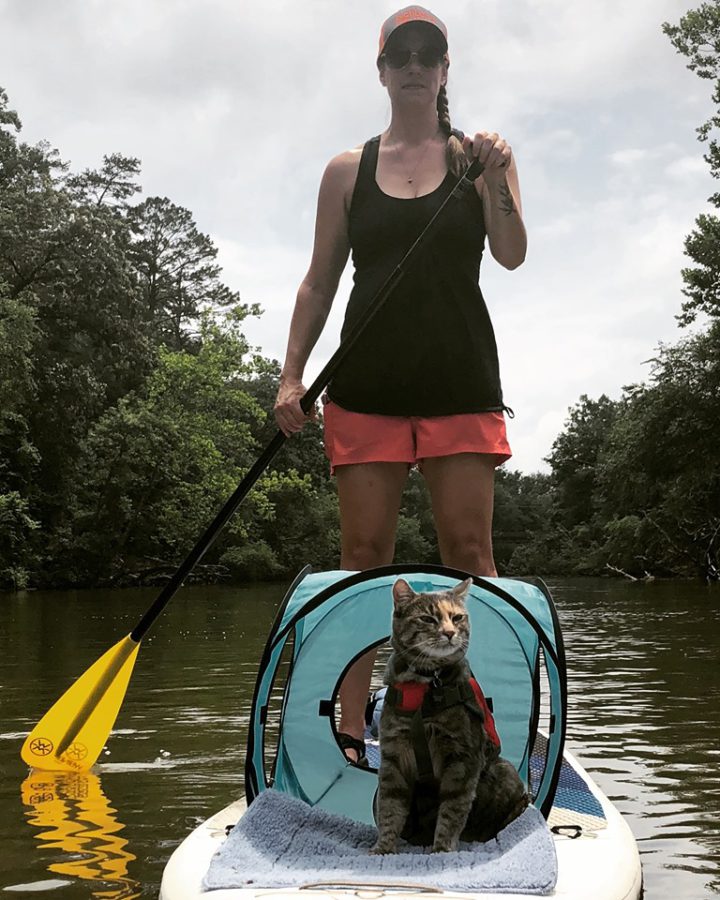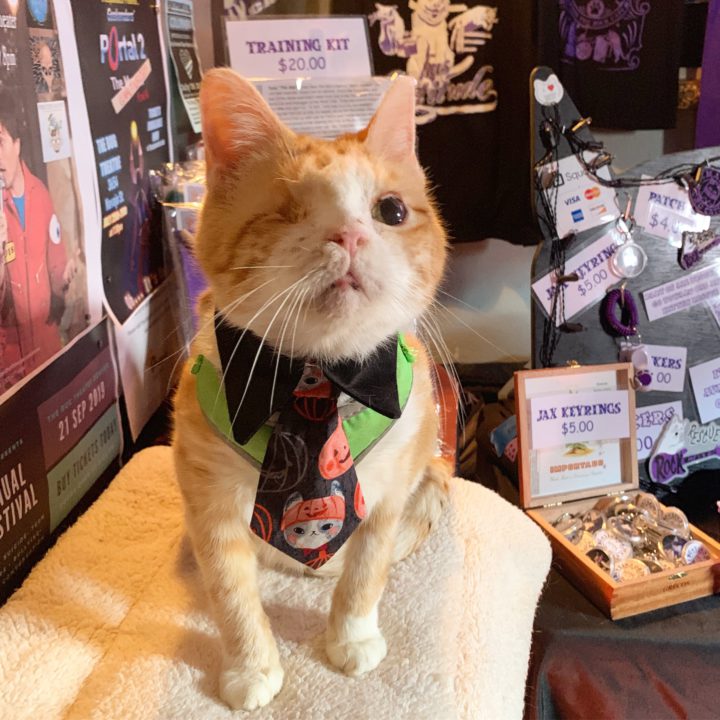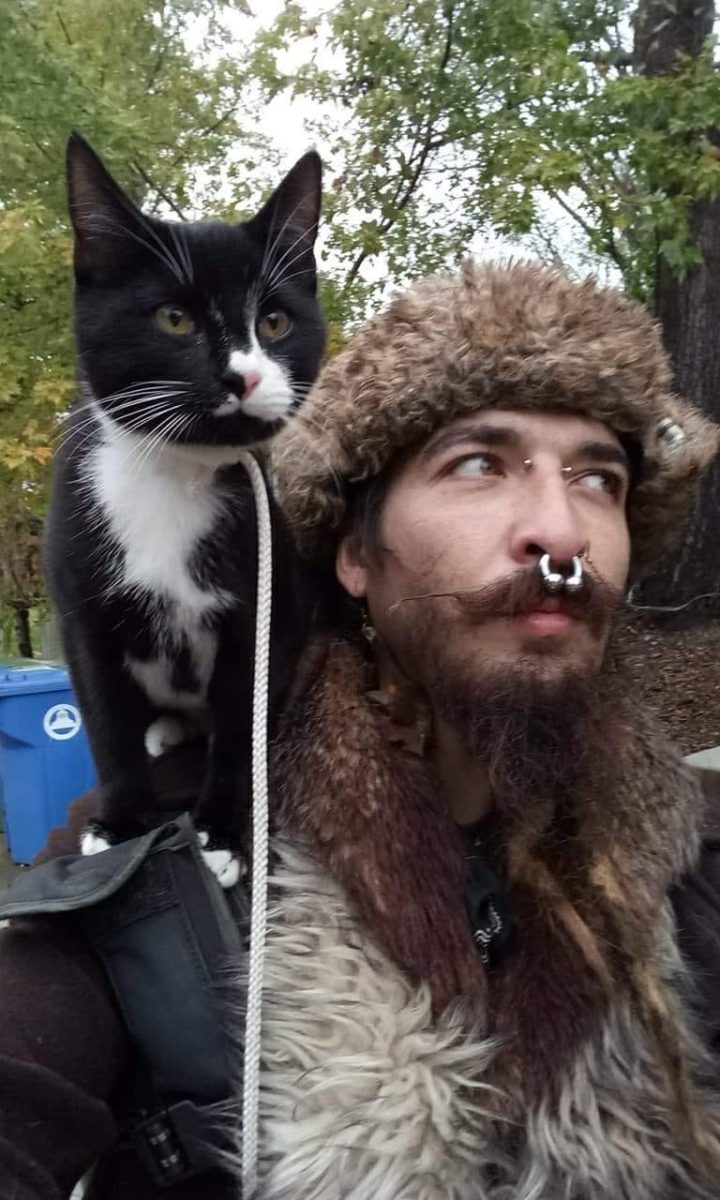At 3 years old and only 8 pounds, Asheville resident Emmylou is already an avid hiker and experienced camper who can canoe with the best of them. She and Annie King are constant companions on excursions in Western North Carolina’s mountains and valleys. But Emmylou isn’t your typical adventure buddy: She’s a cat.
“We’ve done a lot of hiking. She goes whitewater rafting. She’s done up to Class III whitewater in the raft,” says King, a veterinarian at the Pet Vet on Patton.
Don’t worry: Emmylou has her own cat-size life jacket, says King. Safety first.
And while some folks see cats as less outgoing than dogs, cat owners in Asheville and beyond are bucking the stereotype, taking their feline companions to places they’ve never been before. Instagram and Facebook are rife with images of courageous kitties scaling mountaintops, road-tripping across deserts and, yes, whitewater rafting their way into mainstream mountain culture and other social settings.
Judging by King’s own WNC Adventure Cats Facebook group, which boasts more than 300 members and growing, the practice of transforming ordinary house cats into so-called adventure cats may be more than just a passing trend.
For the health of it
While cats may be known for wild or independent tendencies that seemingly no longer exist in dogs, the notion of bringing a feline friend along on outings may not be as far-fetched as it seems, says Veronica Coit. “We don’t have the saying ‘Curiosity killed the cat’ for no reason,” notes Coit, who founded the popular Facebook group Asheville Cat Weirdos. “Cats are naturally pretty inquisitive.”

In fact, she continues, cats are equipped with strong hunting and survival instincts, and the prominence of feral cat populations demonstrates their ability to weather life outdoors. Still, many cat owners raise their pets within the safety of their home, away from predators, traffic, viruses and other perils. And while King encourages clients to prioritize their pets’ safety, she also emphasizes that living indoors exclusively can leave an animal vulnerable to boredom and neurotic behaviors.
“It’s safer for cats to live inside only, but it’s a pretty small world, and it’s not their natural environment at all,” she points out. “With indoors-only cats, we need to provide them with enrichment.”
For some cats, says King, that can mean a constant supply of new toys, a window or even a specially built “catio” where they can be exposed to outside sights and sounds. But for those animals that yearn for the great outdoors, harness training might enable them to venture outside safely. Cats trained to walk with a leash and harness are then better equipped to satisfy some of their instinctual needs while avoiding the biggest threats posed by outdoor living.
“They also get exercise,” adds Coit. “You see a lot of overweight cats, so this kind of outdoor stimulation and play can be a great way to expend some of that energy.”
But outdoors doesn’t necessarily mean back of beyond. For Carmen Bryant and her cat, stimulation includes cozying with the regulars at their favorite local watering hole. Sherlock, she notes, “goes all kinds of places with me, but we like this place the most,” as the 8-year-old orange tabby stretches lazily across the bar at 27 Club on Patton Avenue, unfazed by the surrounding barroom clamor. “He even has a litter box back there by the bathrooms,” says Bryant with a laugh. “Some places have dog water bowls, but they have a litter box.”
(Back) into the wild
Dog owners often boast about how smart and well-trained their pets are. Cat owners, though, might recognize the look of stubborn indifference their pets get when asked to perform even a simple trick. But Asheville resident Debra Baumann says getting a cat to perform is not as daunting as it might seem.
“If your cat is food-motivated, then you can train them, because it’s all based on positive reinforcement,” says Baumann, who works with The Amazing Acro-Cats, a Chicago-based, traveling cat circus features rescued animals. “If they do something you like, if it’s harness training and they wear their harness, you just give them treats. It’s fun and a good way to bond with your cat.”
King, meanwhile, recommends starting small and gradually working up to more extensive adventures. Keep them inside while they adapt to a harness, she advises, and then start by venturing into the backyard or some other controlled environment where they can ease into a new experience. A carrying case or other type of shelter gives your cat a place to retreat to should they become anxious or overstimulated.

“Take it really easy,” urges King. “Cats are not people pleasers, so you have to be superpatient and make them decide that that’s what they want to do.”
And while they say you can’t teach an old dog new tricks, Baumann maintains that it’s different with cats. Her beloved Captain Patch, she says, quickly adapted to life on tour with the circus at the ripe old age of 10, despite having lost an eye when he was just a kitten.
“He really travels everywhere with me. He is so good in the car; he flies with me. He just loves going out and meeting people,” Bauman reveals. “I’d just like to stress that older kitties and even special-needs kitties can be trained. It’s still a really fun experience for them.”
Know the limits
Jewelry artist Dylan Pugh — who’s rarely seen strolling the streets of West Asheville without his year-old tuxedo cat, Dr.

Pickles, perched atop his shoulder — stresses that adventure cat owners must always take extra care when bringing their feline companion outside of its comfort zone. Even well-trained, harnessed cats are still vulnerable to dogs, vehicles and other less predictable threats.
“We’re walking down Haywood Road, and they were having this big event over at the church,” Pugh recalls. “There was this wacky inflatable arm man, and I could just tell that Dr. Pickles got really spooked. He kind of got switchy and dug his claws into me, and I was like, ‘What’s going on?’ It was a generator: It really freaked him out.”
Dr. Pickles, notes Pugh, also generally welcomes the attention of his cadre of adoring fans, but pet owners should be extra mindful during encounters in public spaces. “There have been a couple of times when someone has been obviously drunk or has very enthusiastically approached us, and he’s like, ‘Uhh, I don’t trust this situation,’” Pugh explains.
King concurs, saying it’s the owners’ responsibility to remain aware of their pet’s reactions at all times and be prepared to leave the situation if a cat seems distressed. “There are multiple medical issues that are directly related to stress. There are always going to be times when you want to try something new and then you realize it’s not working.” Emmylou, for example, “does not like bikes,” King says with a laugh. “She doesn’t like to be near them, and she is definitely not going to ride on one.”
Keep it in perspective
Traveling with Dr. Pickles, says Pugh, offers more than just a good photo op: It enables both owner and cat to interact with the community while helping others develop an appreciation for the species.
“It’s so interesting that so many people respond to us as some kind of surreal happening, and I love that,” says Pugh. “It feels great to help people get a small interruption from everyday, so to speak.”
At the same time, cautions Coit, your pet’s safety and well-being must come first. “Yes, the Instagram photos are going to be amazing if you do a trail hike with your cat, but if they’re terrified the whole way, it’s not really fair to them — and you can get just as good photos in your front yard in a safe, controlled environment.”
King agrees. “It is tough with social media, and people get kind of caught up in that, wanting to do things and get the pictures. But you have to take a step back and ask, ‘Are they having fun?’” she maintains. “The point is that you’re trying to expand their world, give them something new to think about — something that they’re going to enjoy.”




You’re kidding me right? Domesticated cats are an invasive species (by definition) in all North American ecosystems. They have no “natural environment” here. A paper was just published in Science that details the loss of 3 billions birds since 1970 (30% of all populations across all habitat types) and, while they don’t surmise any causation in the paper, it is known that cats are one of the major causes of bird declines. Their “wild and independent tendencies” and “strong hunting and survival instincts” are something that cat owners are responsible for preventing, not encouraging. Cats do not belong in the outdoors.
My initial reaction to this article had nothing to do with the threats to the cat’s safety. I don’t care about the “predators, traffic, viruses or other perils,” or if the cat has it’s own life jacket (really?). The cat’s safety should come right after the safety of the environment. Those two don’t mix.
CATS DO NOT BELONG OUTDOORS.
I just had to put my 2 cents in since james up there in the first comment is a very obvious advocate for the wild birds and keeping all cats inside for their entire lives. Anyways, I have a 10 year old orange tabby named Teddy. He is not as adventurous as the cats in this article, but he does enjoy adventures on his schedule. We have cruises around town in my car, gone to brewery’s, went hiking to waterfalls in summer and winter, even taken a dip in a lake after a long hike. He can be in his back pack but prefers the sling or to walk on his own. He’s a very special boy who came into my life unexpectedly when we was about 5 years old. I am a veterinary technician and he was surrendered to the clinic I was working at because he had a urinary blockage. He was unblocked and recovered. I eventually was able to take him home with me. Teddy is either very complacent or fearless. I’ve seen a large angry dog bark half a foot from his face and he stood there blinking at it unphased. Teddy has enriched my life in so many ways. I never thought I’d be able to take one of my cats with me on adventures. I hope I have enriched his life as well. And it’s wonderful to be out and see people get excited to see a kitty hiking or hanging out at a brewery. I encourage those of you who are interested in either raising an adventure cat or training your kitty to be an adventure cat to educate yourself on how and understanding not all cats want to adventure and that’s okay. And I promise james to not let Teddy catch any birds (he’s on a leash anyways).